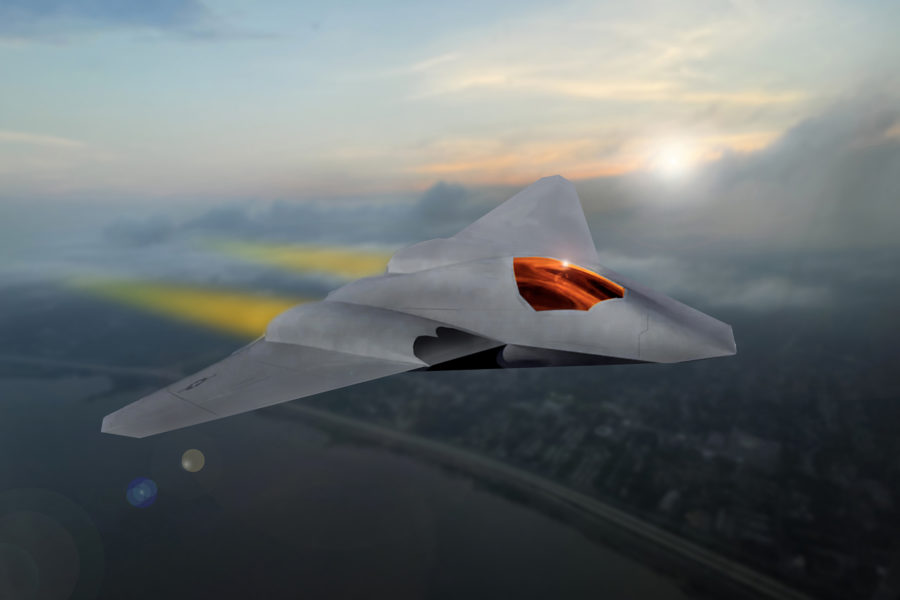The future of the Air Force’s next-generation combat jet will be decided by the end of the year, the service’s top officer said Oct. 25.
“We intend to have that by December,” Chief of Staff Gen. David W. Allvin said at the Military Reporters and Editors Conference in Washington, D.C. “We also want to be able to influence the Department’s Presidential Budget Submission in February.”
As currently conceived, the Next-Generation Air Dominance (NGAD) combat aircraft is a “very expensive, very capable crewed platform,” Allvin said. The Air Force paused the project this summer as it was reaching a decision point for choosing between competing designs to replace the F-22 Raptor. Rather than commit, Air Force Secretary Frank Kendall wanted to make sure the Air Force wasn’t betting its future on a capability that might be had at lower cost if requirements were changed.
The NGAD design precedes the progress USAF has made with semi-autonomous Collaborative Combat Aircraft (CCA). Allvin said the Air Force plans to have more than 150 CCAs in service within the next five years.
CCAs don’t require life-support systems and could be developed at a fraction of the cost of manned fighters. That’s raising questions about what the mix of unmanned and manned aircraft should be.
“NGAD is a family of systems,” Allvin said. “One piece of the system is the NGAD penetrating counterair crewed platform. Some would say it’s the follow-on to the F-22. … It is part of a family of systems. That family of systems includes Collaborative Combat Aircraft, which are uncrewed. But those are already underway.”
The Air Force is studying its future force design at the same time, driven by China’s growing military and its anti-access/area denial strategy in the South China Sea. The manned NGAD platform was supposed to be able to penetrate those defenses, but the threat today is greater than it was just a few years ago.
“The ability to say, ‘We know that when this platform delivers, it is going to meet the threat’—I think we’re less certain about that than we were when we designed it,” Allvin said.
“We are now in the point where … if we go down this path, this will be a very, very costly program,” Alvin added. “The question is, with the cost, the capability, and where the threat is, is it the right [choice]?”
Pausing to consider all the options is not “slow rolling or stalling,” Allvin said. “I would call it something that’s prudent because once we go through this one-way door, it’s hard to pivot.”
The Air Force has pegged the cost of NGAD at “hundreds of millions of dollars,” but Kendall said in September that he wants NGAD capability in a far less costly platform: no more than the cost of today’s F-35—less than half the cost of the projected NGAD crewed aircraft.
CCAs are what changed Kendall’s thinking. Designed to work in close collaboration with F-35s and B-21 Raider bombers, they could reduce the requirement for a penetrating combat jet and make additional B-21s more attractive to Air Force planners. The Air Force has never said NGAD would resemble the F-22 or other fighter-type platforms, designed to outmaneuver rival fighters. Its mission is to penetrate and suppress enemy air defenses, which might make it more like a smaller, faster stealth bomber.
Would the Air Force consider buying more than the 100 B-21s now planned? Allvin answered: “We have not taken that off the table.”
Yet developing and fielding crewed NGAD aircraft remains a possibility, Allvin said. “I don’t like people having the presupposition that because we’re pausing and analyzing, we’re walking away from it,” he said. “That decision has not been made.”
A blue-ribbon panel, including three former Air Force Chiefs of Staff, one former Vice Chairman of the Joint Chiefs, and two leading civilian experts is reviewing the evidence now and will recommend a way forward in December.
“As we are analyzing this, we need to understand, ‘Is this the best for the cost of what we think the threat is going to be?’ and ‘Is this the best way to be able to achieve air superiority?’” Allvin said. “And if it turns out that this platform design, as currently instantiated, is the best … we have to figure out how to pay for it.”
